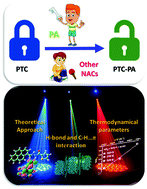Mechanistic and thermodynamic aspects of a pyrene-based fluorescent probe to detect picric acid†
Abstract
A remarkable flourescent (FL)-based Schiff base probe [(2E/Z)-2-(9-pyrenylmethylene)yrenylmethyle-thiophene-carboxylic acid or PTC] was employed for the rapid analytical detection of Cu2+ and picric acid (PA) up to the nM level. Although, there have been several literature reports on the utilization of fluorescent probes for the efficient sensing of explosives in the last few years, there has been no such report on the reaction spontaneity between a ‘probe-explosive’ ensemble in equilibrium. Herewith, in the present study, for the first time, a detailed thermodynamic investigation was performed and reported. Temperature-dependent thermodynamic studies revealed a high negative Gibbs free energy, with ΔG values of −120.3 kJ mol−1 to −123.0 kJ mol−1 obtained for the PTC–PA adduct. Interestingly, there was a steady decrease in the ΔG values with the increase in temperature along with a consecutive increment in the Stern–Volmer constant (KSV). This suggests that the spontaneous adduct formation equilibrium for the ‘probe-picric acid’ ensemble becomes stronger with the increase in temperature. A negative ΔH value of −81.77 kJ mol−1 confirmed that the spontaneous adduct formation in equilibrium was exothermic in nature. Apart from the sensing of picric acid, PTC and the PTC + Cu2+ complex possess the ability to permeate cells and thus, they were explored for the imaging of living cells. Moreover, agreement between the theoretical and experimental findings on the PET-based sensing mechanism indicated that the extensive conjugation of the pyrene system attached to the adjacent imine along with the higher electric potential, encompassing the thiophene ring are very much instrumental in PTC acting as a PA sensor.



 Please wait while we load your content...
Please wait while we load your content...